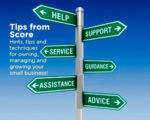Brand Management
 Question: I know that making a good first impression is critical to your small business when selling. What tips can you give to assure that we are making that impact on current and potential customers?
Question: I know that making a good first impression is critical to your small business when selling. What tips can you give to assure that we are making that impact on current and potential customers?
Answer: You are right. There is an axiom in business and life, “you only have one chance to make a great first impression.” The challenge is that if you don’t make that great impression the first time, there may not be a second chance and it takes a lot of energy and resources to change an impression that is askew. Consider the following:
Smile the first and most effective tool for making a good impression is to smile. A smile says, I am warm, comfortable and relaxed. I am to be trusted and want to connect with you. When you smile, others will smile in response and therefore feel more connected.
Be punctual no one likes to wait past an agreed upon time to meet. If you schedule an appointment for 9 am, then arrive at 8:50 am to assure you are ready when your customer is ready. If you know that you are going to get hung up in traffic due to an accident, call and advise your customer in advance of the appointment time. It is not only courteous but signals you value them and their time. If you say you need 30 or 45 minutes of their time to complete an estimate, make sure you take just less than the allotted time to again signal your appreciation of them. If you say, you will call back in a day or two to discuss the proposal or corrective action, make an agreement on the day and time when the call will take place to assure you both are on the same track.
Dress for the occasion there is another saying, “you are what you wear.” The first impression of a salesman entering a prospect’s office is “shined shoes.” Many times whether you are seriously considered is a function of how you appear visually to the buyer. If you are a tradesman or woman wearing a clean, pressed shirt with your company logo emblazoned on the pocket, across a sleeve or on the collar, you are dressing to impress. You might even do as Starboard Side Landscaping in Dennis does by assigning one person to the initial customer contact and preparing quotes who are not involved in the actual execution of the work. They are dressed to impress.
Listen with the intent to understand, not just reply. Stephen Covey in 7 Habits of Highly Effective People talked about how important being an empathic listener is to both sides of the conversation. Most salespeople are not good listeners since they have an agenda they hope will culminate in a good sale. However, if you are not tuned into the buyer and their agenda, you will miss their needs for which your product or service will provide a solution. Selling is all about finding a need and filling the need. You have to be a good listener to achieve that customer service goal.
Don’t pitch your product or service. Provide solutions in response to stated needs. It is easy to pitch your product. You know the features, functions, and benefits of what you offer and it is easy for you to expound upon them. The challenge is to internalize prospect needs and then customize your offerings, so they see the solution and buy into your ability to fulfill their needs.
Lastly, nonverbal communications – your first impression is capped by not only what you say and how you say it, but your nonverbal communications. 55-60% of all communications is nonverbal. While your buyer is explaining their situation, they are taking in the nonverbal messages you are displaying while listening. They can tell if you are tuned in or tuned out just waiting for your turn to talk. If you are looking off into space, they know you are tuned out. (Make positive eye contact throughout the conversation.) However, if you are stroking your chin as they talk, they know you are interested and considering what they are saying. If you interrupt them, you have just destroyed the value of the communication. And it is rude. ( If you think they have finished their commentary, count to 3 to yourself. If they haven’t resumed talking, they are finished, and you can talk without interrupting them.) Think about the words you use, the nonverbal messages you deliver and how you listen as a total package to create a positive first impression.











